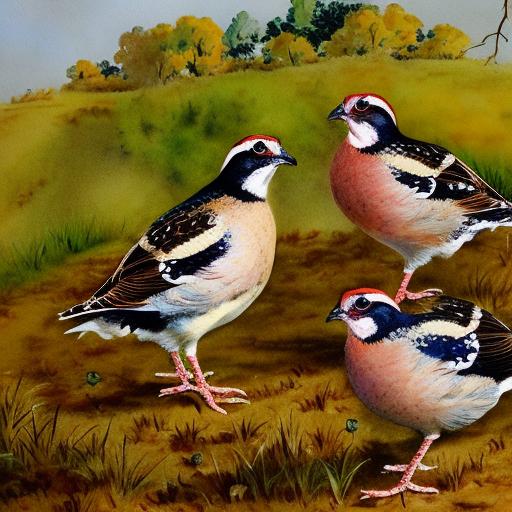Meat quail breeds are a popular choice for many farmers and homesteaders looking to raise their own meat. Quail are small game birds that are known for their delicious and tender meat, making them a great option for those looking to add variety to their protein sources. There are several different breeds of quail that are specifically bred for their meat production, each with their own unique characteristics and benefits. In this article, we will explore the characteristics of meat quail breeds, popular breeds, the benefits of raising meat quail, considerations for choosing the right breed, and the care and maintenance required for raising these birds.
Key Takeaways
- Meat quail breeds are specifically bred for their meat production and are popular among small-scale farmers and homesteaders.
- Meat quail breeds are known for their fast growth, high meat-to-bone ratio, and efficient feed conversion, making them a cost-effective option for meat production.
- Popular meat quail breeds include the Jumbo Coturnix, Italian, and Tuxedo, each with their own unique characteristics and advantages.
- Raising meat quail provides a sustainable source of protein, requires minimal space and resources, and can be a profitable venture for farmers.
- When choosing meat quail breeds, consider factors such as climate adaptability, egg production, and temperament, and ensure proper care and maintenance for optimal meat production and overall well-being of the quail.
Characteristics of Meat Quail Breeds
Meat quail breeds are known for their fast growth and high meat-to-bone ratio, making them an efficient and economical choice for meat production. These breeds are typically larger in size compared to other quail breeds, with plump bodies and well-developed breast muscles. They also have a high feed conversion rate, meaning they can efficiently convert feed into meat, making them a cost-effective option for meat production. Additionally, meat quail breeds are known for their docile temperament, making them easy to handle and manage. They are also adaptable to various climates and can thrive in a range of housing and environmental conditions, making them a versatile option for farmers and homesteaders.
In addition to their meat production capabilities, meat quail breeds are also known for their high egg production. This dual-purpose nature makes them a valuable addition to any farm or homestead, as they can provide both meat and eggs for consumption. Their small size also makes them a practical choice for those with limited space, as they require less room compared to larger livestock animals. Overall, the characteristics of meat quail breeds make them a practical and efficient choice for those looking to raise their own meat.
Popular Meat Quail Breeds
There are several popular meat quail breeds that are commonly raised for their meat production. One of the most popular breeds is the Jumbo Coturnix quail, also known as the Pharaoh quail. This breed is known for its rapid growth and large size, making it a top choice for meat production. Another popular breed is the Italian or Tuxedo quail, which is prized for its attractive plumage and high meat-to-bone ratio. The Texas A&M quail is another popular breed known for its fast growth and high egg production, making it a dual-purpose option for farmers and homesteaders.
Other popular meat quail breeds include the Tibetan quail, British Range quail, and Manchurian Golden quail. Each of these breeds has its own unique characteristics and benefits, so it’s important to research and consider the specific needs of each breed before making a decision on which to raise. Ultimately, the popularity of these meat quail breeds is a testament to their efficiency and practicality for meat production.
Benefits of Raising Meat Quail
There are numerous benefits to raising meat quail, making them an attractive option for farmers and homesteaders. One of the primary benefits is their fast growth and high meat-to-bone ratio, which makes them an efficient and economical choice for meat production. This means that farmers can raise a significant amount of meat in a relatively short amount of time, reducing the need for long-term investment in feed and resources. Additionally, meat quail breeds are known for their high egg production, providing an additional source of protein for consumption.
Another benefit of raising meat quail is their small size, which makes them a practical choice for those with limited space. Quail require less room compared to larger livestock animals, making them a viable option for urban or suburban homesteads. Their adaptability to various climates and housing conditions also makes them a versatile choice for farmers in different regions. Overall, the benefits of raising meat quail make them an attractive option for those looking to produce their own meat in a cost-effective and efficient manner.
Considerations for Choosing Meat Quail Breeds
When choosing a meat quail breed to raise, there are several considerations to keep in mind. One important factor to consider is the specific needs and characteristics of each breed. For example, some breeds may be better suited for cold climates, while others may thrive in warmer environments. It’s important to research the specific requirements of each breed and consider how well they align with your own farming or homesteading setup.
Another consideration is the intended purpose of raising quail. If your primary goal is meat production, you may want to prioritize breeds known for their rapid growth and high meat-to-bone ratio. On the other hand, if you’re interested in both meat and egg production, you may want to consider dual-purpose breeds that excel in both areas. Additionally, it’s important to consider the availability of resources such as feed and housing, as well as local regulations and restrictions that may impact your ability to raise quail.
Ultimately, the decision on which meat quail breed to raise will depend on your specific goals, resources, and circumstances. It’s important to carefully consider these factors before making a decision in order to ensure the success and sustainability of your quail-raising venture.
Care and Maintenance of Meat Quail Breeds

Proper care and maintenance are essential for raising healthy and productive meat quail. One important aspect of care is providing a suitable housing environment for the quail. This includes providing adequate space, ventilation, and protection from predators. Quail also require access to clean water and a balanced diet that meets their nutritional needs for growth and egg production.
Regular monitoring of the quail’s health is also important to identify any potential issues early on. This includes observing their behavior, checking for signs of illness or injury, and maintaining proper hygiene in their living environment. Additionally, regular cleaning and maintenance of their housing area is essential to prevent the buildup of waste and bacteria that can lead to health problems.
Another important aspect of care is handling the quail in a gentle and stress-free manner. This includes minimizing disturbances in their environment, handling them with care when necessary, and providing enrichment activities to promote their well-being. Overall, proper care and maintenance are crucial for ensuring the health and productivity of meat quail breeds.
Conclusion and Final Thoughts
Meat quail breeds are a practical and efficient choice for those looking to raise their own meat in a cost-effective manner. Their fast growth, high meat-to-bone ratio, and dual-purpose nature make them an attractive option for farmers and homesteaders. When choosing a meat quail breed to raise, it’s important to consider the specific characteristics and needs of each breed, as well as your own goals and resources.
Proper care and maintenance are essential for raising healthy and productive meat quail. This includes providing a suitable housing environment, monitoring their health, and handling them in a gentle manner. With careful consideration and proper care, raising meat quail can be a rewarding endeavor that provides a sustainable source of meat and eggs for consumption.
If you’re interested in learning about different quail breeds, you might also want to explore how to raise chickens for your family. Understanding the number of chickens needed for a family of four, as discussed in this article, can provide valuable insights into poultry farming. Additionally, exploring chicken coop interior ideas and designs, such as those featured in the articles on Poultry Wizard, can offer inspiration for creating a comfortable and efficient space for your quail and chickens.
FAQs
What are meat quail breeds?
Meat quail breeds are specific breeds of quail that are raised for their meat production. These breeds are selected and bred for their ability to grow quickly and produce high-quality meat.
What are some popular meat quail breeds?
Some popular meat quail breeds include the Jumbo Coturnix quail, Pharaoh quail, Italian quail, and Tibetan quail. These breeds are known for their fast growth and high meat yield.
What are the characteristics of meat quail breeds?
Meat quail breeds are typically larger in size compared to other quail breeds. They have a fast growth rate, reaching maturity in as little as 6-8 weeks. They also have a high meat-to-bone ratio, making them ideal for meat production.
How are meat quail breeds raised?
Meat quail breeds are typically raised in controlled environments such as cages or aviaries. They are provided with a balanced diet to support their rapid growth and are often kept in groups to minimize stress and aggression.
What are the benefits of raising meat quail breeds?
Raising meat quail breeds can be beneficial for small-scale farmers and homesteaders looking to produce their own meat. Quail meat is considered a lean and nutritious protein source, and meat quail breeds can be raised in a relatively small space compared to other livestock.
Meet Walter, the feathered-friend fanatic of Florida! Nestled in the sunshine state, Walter struts through life with his feathered companions, clucking his way to happiness. With a coop that’s fancier than a five-star hotel, he’s the Don Juan of the chicken world. When he’s not teaching his hens to do the cha-cha, you’ll find him in a heated debate with his prized rooster, Sir Clucks-a-Lot. Walter’s poultry passion is no yolk; he’s the sunny-side-up guy you never knew you needed in your flock of friends!







